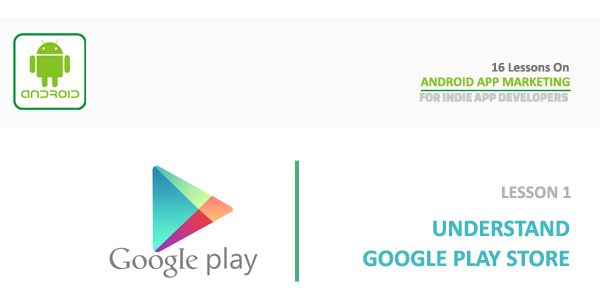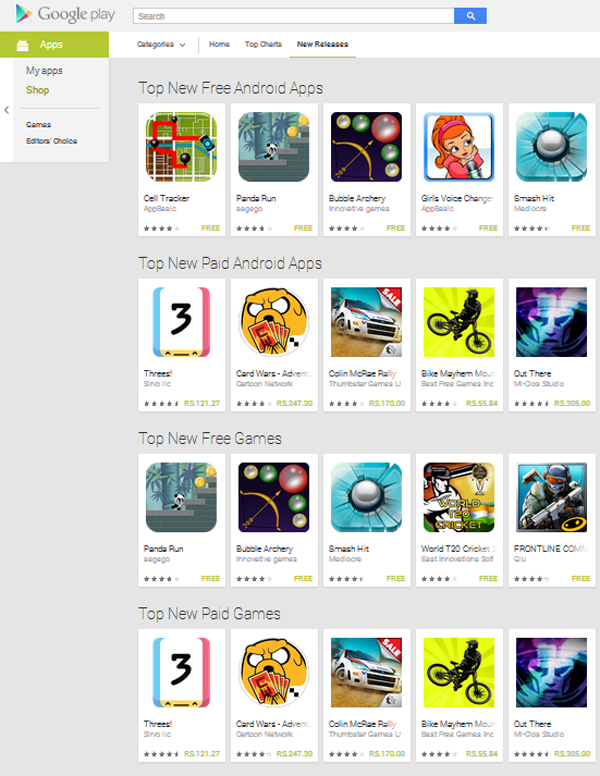by wp-admin | Mar 18, 2014 | Android App Marketing |

Before you can even consider how to use android app marketing you need to be a google play store expert from a user perspective. If you know how everyday people use the play store and how it functions they you will be able to use android app marketing more effectively and it can help make your life easier.
Luckily the play store is easy to navigate and understand because it is for the everyday person. Initially in the play store there will be six main categories and a search option that someone can choose from. The biggest hits from these categories are “apps” and “games”. If someone, for example wanted to find a game they would choose to look at games (feel free to follow along on your own device as this is how someone who does not know about your app will most likely find it). There are different categories to choose from on the game page also:
Home: This will include different types of games (sport, racing, action, etc) and things like “recommended for you”. Recommended games come from previous downloads and are picked based on the genre of games you previously downloaded.
Top paid and Top free: These categories show the top games that are free and paid apps. The top games are determined by download and rating ratio. This system is there so a game with ten million downloads and all one star reviews, and a game with one download and a five star review do not accidentally make it onto the top list.
Top grossing: The top grossing apps are a mix of free and paid apps. grossing means apps that people are spending the most money on using in-app purchases.

Knowing how to use the play store is very important when it comes to marketing because you need to know how the users view it. While this was very vague going into the play store it is enough to know what a user see’s and where they are likely to end up
Complete list of Android App Marketing Lessons
by wp-admin | Feb 14, 2014 | Blogs |

Large and small companies are deploying all kinds of marketing strategies and campaigns to increase their sales as well as their profits. Keeping people engaged in their marketing campaigns is on the top of the list of their techniques and strategies. Since mobile phones have been added to the mix, the trends have been changing dramatically as many companies are struggling to find out what works best. This is why so many different types of companies in diverse industries are using mobile engagement and mobile re-targeting as a prominent segment in their marketing strategies.
By using mobile engagement and mobile re-targeting as a viable option for attracting and keeping customers, most companies are looking to optimize their marketing campaigns. In order for these campaigns to work effectively, marketing specialists are looking at the numbers to see how the are affected when a new campaign has been deployed. For instance, if the target audience that they are trying to attract is not engaged or responds as they predict, they may have to use mobile re-targeting to correct the situation that they see. On the other hand, if the target audience that they pre-select remains engaged and would like more products and services, the campaign can be re-deployed to larger target audience. Whatever the situation, mobile engagement and mobile re-targeting requires a lot of planning and well-thought out goals and objectives if they are going to be effective. For instance, before a marketing team implements the plans that they design, they may want to send the proposed ads to a small beta group to see how they respond. If these ads are received positively, the team can begin releasing these ads to broader target audience.
Mobile engagement and mobile re-targeting are two strategies that’s being used by both small and large companies. Using these techniques and strategies, however, requires a great deal of planning before they can be released via a mobile marketing scheme. When they are successful, companies can increase their sales and profits by substantial amounts.
by wp-admin | Feb 14, 2014 | Blogs |

According to Nielsen, over 80% of all tablet owners, 35% of male smartphone owners and 40% of female smartphone owners admit to using their devices while watching TV. Studies have shown that using these devices increases brand recognition by 70 and 300% for most users i.e. future customers. The potential for cross platform app marketing is incredible.
Larger TV screens mean bigger ads that still attract a user’s attention even while they are using a tablet or smartphone. Since an increasing number of users already consider their devices as a way to enhance their TV watching, they already have their devices in hand. Digital media consumption has doubled in the last three years thanks to multi-platform usage. With a multi-platform, cross marketing campaign, you stay connected to your potential customer base as long as they are awake. Searching for your app after it appears on the TV screen is done in a matter of seconds.
What’s better than that? A fast purchase and lots of them. There is a growing part of the population called “cocooners”; these people center their recreation time and social life on their TV and Internet Devices. On average, they earn $75,000 a year. This is your target audience.
Getting started is simple but it will be time-consuming. Once you’ve set your budget and business goals, you’ll need to design banners and develop the actual advertisements. Once you’ve completed these deceptively easy sounding steps, it’s time to find a media buyer to help you line up your TV ads, traffic sources and mobile ad networks. Make certain you use a platform that can track all three ad campaigns in order to measure your Return on Investment (ROI) to get the most for your money.
by wp-admin | Feb 11, 2014 | Blogs |

The app market is a growing industry with tons of competition. With more than 500,000 apps available at the touch of your fingers, how to get noticed and keep selling are essential keys to the success of your app. SEO and AEO tools can get you noticed, but what are the best tools to keep you selling? Once you’re on the radar, cross-selling and up-selling can keep you growing.
Cross-selling is the art of getting your customers to buy more than one product. Developers with more than one app under their belt can do this by including advertisements for other app products within each app. For example, the wildly successful Candy Crush app includes pop-up advertisements for other games after each level is complete, before you can move on to the level.
Up-selling, on the other hand, might involve getting your customer to buy more content for the app they already purchased. Some apps offer free content, but entice the customer to purchase more by offering a paid upgrade that eliminates ads in the app, or desirable content that must be purchased.
In order to have an app that continues to sell and grow, the use of up-selling and cross-selling should be an integral part of your app marketing strategy.
by wp-admin | Feb 10, 2014 | Blogs |

Marketing app on mobile phones requires skill and knowledge on how advertising operates. These marketing skills are a little different from the traditional product marketing although a few tips could be borrowed.
Here are the most common mistakes in app marketing.
Lack of a proper marketing strategy
When developing an app for sale, it is important to factor in the mode of marketing one intends to use. Having your app advertized on all those sites does not guarantee downloads. The way it appears is quite important. Do not make the ad long and tiring. The instructions on it should be clear. Use fewer words to convey the message. You should also be very careful with your choice of words for the descriptions, titles and keywords. Make the important words stand out. It would also help if you place a segment for satisfied customers to give their feedback for other targeted users to read.
Creating web- based apps
This is another grievous mistake made by app developers who want to make their work easier. A successful app should be able to work even in areas that have low or no internet connections. Building native apps can be a cumbersome endeavor but it pays off eventually as it is preferred by most Smartphone users. If you find it absolutely necessary to use multiple platforms, use one whose programming language supports native apps such as Xamarin, Corona Labs and PhoneGap.
Treating Mobile phones like desktops
This common mobile app marketing error is done by creating a mobile app to look exactly like a desktop app, only on a smaller screen a mobile phone app should have less features than those in a desktop app. This is because a mobile screen is smaller hence it is harder to input details. When developing this app, ensure you simplify it by including the steps that are extremely necessary and leave out those that the app can do without on the mobile. Also use larger buttons as this will make the app easier to manage.
No channels of communication between consumers and developers
Just because a consumer downloads your app, you cannot be guaranteed that they will continue to use it. Not being able to satisfy the customer beyond installation may cost you as a developer and marketer of the app. You should consider providing a feedback platform because sometimes consumers may have issues and queries that need response. When they are not able to get this, uninstalling your app and getting a better phone will be their only option.
Lack of a customer retention plan
Concentrating only on the number of downloads your app gets is a drawback as far as app developing and marketing is concerned. Design your app in a way that will ensure your audience will retain them after download. In case of a game, if it is too easy to finish, the consumer gets bored. If too difficult, they get frustrated. Make sure your app is easy to understand and use. Also, it is advisable to come up with a mechanism that occasionally reminds the consumer that the app exists in their device by providing upgrades and updates.






